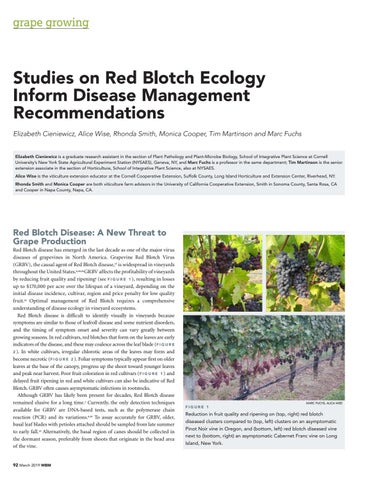grape growing
Studies on Red Blotch Ecology Inform Disease Management Recommendations Elizabeth Cieniewicz, Alice Wise, Rhonda Smith, Monica Cooper, Tim Martinson and Marc Fuchs Elizabeth Cieniewicz is a graduate research assistant in the section of Plant Pathology and Plant-Microbe Biology, School of Integrative Plant Science at Cornell University’s New York State Agricultural Experiment Station (NYSAES), Geneva, NY, and Marc Fuchs is a professor in the same department; Tim Martinson is the senior extension associate in the section of Horticulture, School of Integrative Plant Science, also at NYSAES. Alice Wise is the viticulture extension educator at the Cornell Cooperative Extension, Suffolk County, Long Island Horticulture and Extension Center, Riverhead, NY. Rhonda Smith and Monica Cooper are both viticulture farm advisors in the University of California Cooperative Extension, Smith in Sonoma County, Santa Rosa, CA and Cooper in Napa County, Napa, CA.
Red Blotch Disease: A New Threat to Grape Production Red Blotch disease has emerged in the last decade as one of the major virus diseases of grapevines in North America. Grapevine Red Blotch Virus (GRBV), the causal agent of Red Blotch disease,17 is widespread in vineyards throughout the United States.6,10,16 GRBV affects the profitability of vineyards by reducing fruit quality and ripening4 (see F I G U R E 1 ), resulting in losses up to $170,000 per acre over the lifespan of a vineyard, depending on the initial disease incidence, cultivar, region and price penalty for low quality fruit.14 Optimal management of Red Blotch requires a comprehensive understanding of disease ecology in vineyard ecosystems. Red Blotch disease is difficult to identify visually in vineyards because symptoms are similar to those of leafroll disease and some nutrient disorders, and the timing of symptom onset and severity can vary greatly between growing seasons. In red cultivars, red blotches that form on the leaves are early indicators of the disease, and these may coalesce across the leaf blade (F I G U R E 2 ). In white cultivars, irregular chlorotic areas of the leaves may form and become necrotic (F I G U R E 2 ). Foliar symptoms typically appear first on older leaves at the base of the canopy, progress up the shoot toward younger leaves and peak near harvest. Poor fruit coloration in red cultivars (F I G U R E 1 ) and delayed fruit ripening in red and white cultivars can also be indicative of Red Blotch. GRBV often causes asymptomatic infections in rootstocks. Although GRBV has likely been present for decades, Red Blotch disease remained elusive for a long time.1 Currently, the only detection techniques available for GRBV are DNA-based tests, such as the polymerase chain reaction (PCR) and its variations.6,16 To assay accurately for GRBV, older, basal leaf blades with petioles attached should be sampled from late summer to early fall.15 Alternatively, the basal region of canes should be collected in the dormant season, preferably from shoots that originate in the head area of the vine. 92 March 2019 WBM
FIGURE 1
MARC FUCHS, ALICA WISE
Reduction in fruit quality and ripening on (top, right) red blotch diseased clusters compared to (top, left) clusters on an asymptomatic Pinot Noir vine in Oregon, and (bottom, left) red blotch diseased vine next to (bottom, right) an asymptomatic Cabernet Franc vine on Long Island, New York.
